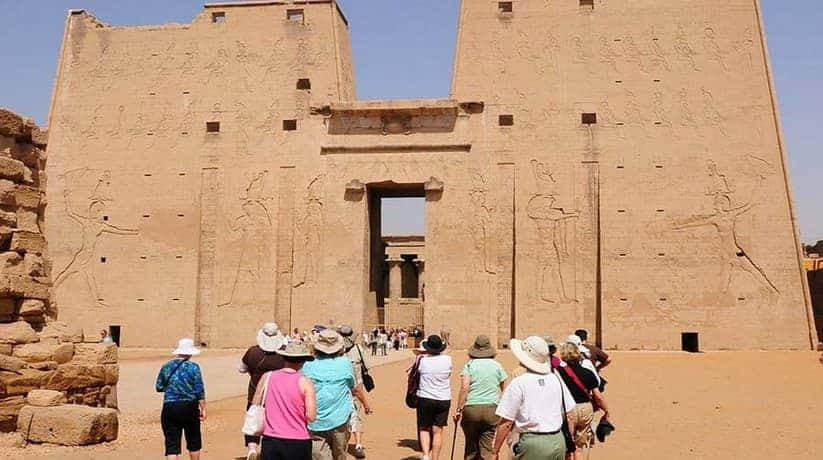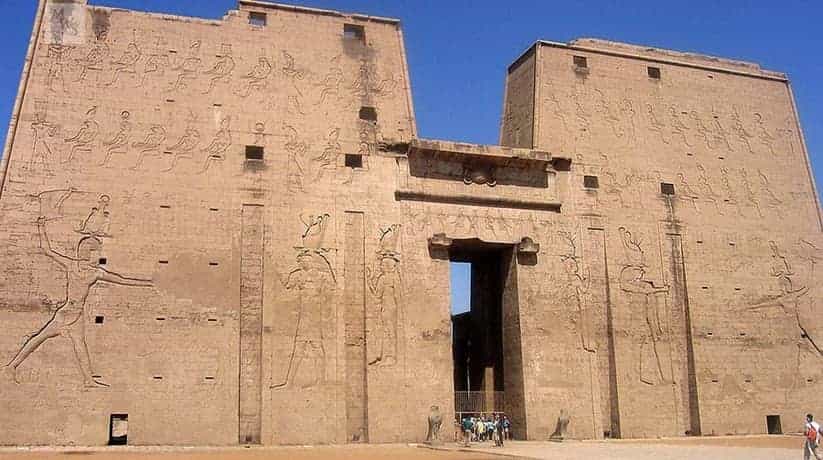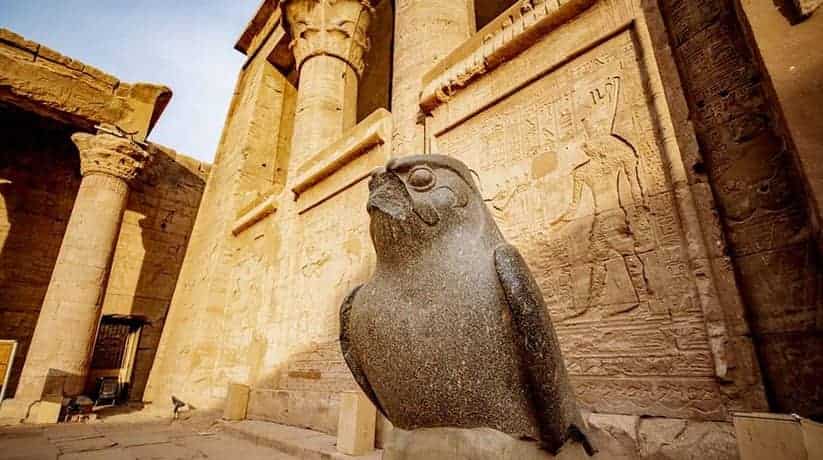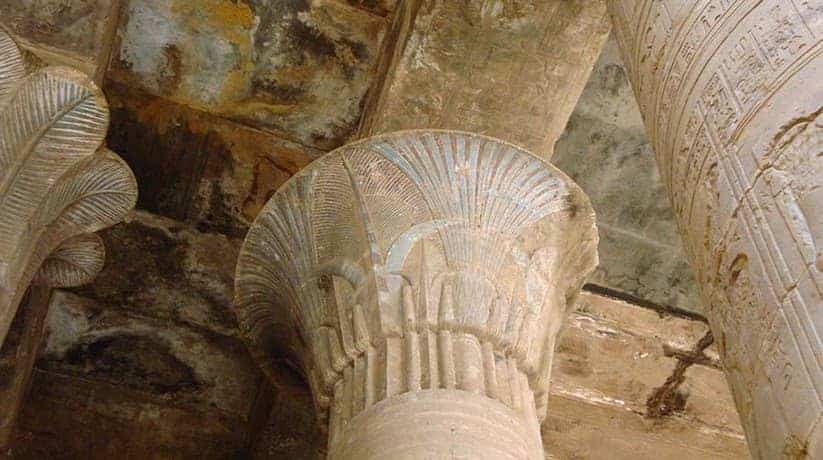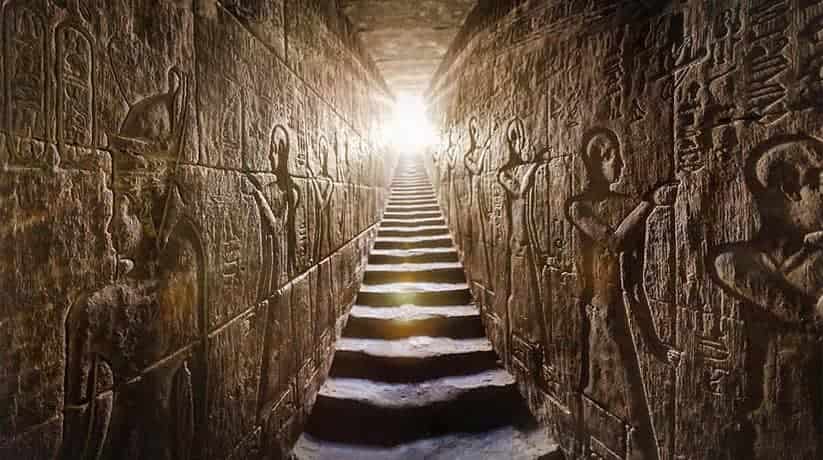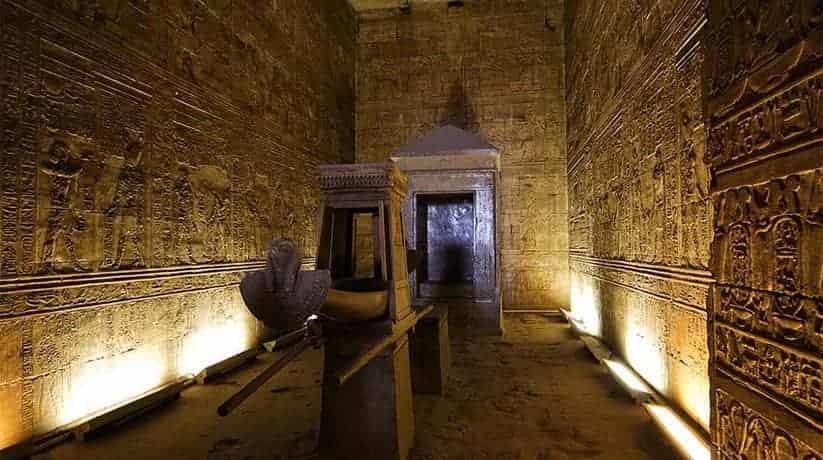Edfu temple Aswan Egypt tours, booking, prices, reviews
Edfu temple Aswan in Egypt also called Horus temple. In fact, the temple dedicated to Horus, the falcon headed god. That is why it known as Horus temple. The temple located 60 kilometer north to Aswan in Egypt. Edfu was the 2nd Nome of Upper Egypt and also the center of the cult of a triad of Gods. It consisted of Horus of Behdet, Hathor, and their son, Hor-Sama-Tawy. In the old Greek documents Edfu known as “Apollopolis Magna”. In fact, it is because the Greeks identified Horus with their God Apollo. Edfu temple Aswan built during the reigns of six Ptolemies. We have a great deal of information about its construction from reliefs on outer areas. In fact, the temple begun in 237 BC by Ptolemy III Euergetes I and finished in 57 BC.
Most of the work continued throughout this period with a brief interlude of 20 years. It is while there was unrest during the period of Ptolemy IV and Ptolemy V Epiphanes. Horus temple is the best preserved ancient temple in Egypt. Moreover, Edfu temple Aswan is also the second largest after Karnak temple. Horus temple Aswan built on the site of the great battle between Horus and Seth. Hence, the current temple was the last in a long series of temples build on this location. Furthermore, the original structure which houses a statue of Horus was a grass hut which built in prehistoric times. In addition, there is an earlier and smaller pylon of Ramses II . It sits in a 90 degree angle to the current building.
The history of Edfu temple Aswan Egypt:
In 332 BC, Alexander the Great conquered Egypt. After his death in 323, his successors ruled Egypt under the Ptolemaic Dynasty. This was the last dynasty of independent Egypt. The Ptolemies were Greeks but presented themselves to the Egyptians as native pharaohs. Moreover, they imitated the traditions and architecture of Pharaonic Egypt. Horus temple built during the Ptolemiac era on top of an earlier temple to Horus. It oriented east-west instead of the current north-south configuration.
In fact, the oldest part of Edfu temple Aswan is the section from the Festival Hall to the Sanctuary. It begun by Ptolemy III in 237 BC and completed by his son, Ptolemy IV Philopator. The Hypo-style Hall added only by Ptolemy VII (145-116 BC) and the pylon erected by Ptolemy IX (88-81 BC). Furthermore, the final touches to Horus temple added under Ptolemy XII in 57 BC. The falcon-headed Horus was the sky god, whose eyes were the sun and moon. He later assimilated into the popular myth of Isis and Osiris as the divine couple’s child. Horus raised by Isis and Hathor after Osiris’ murder by his brother Seth. He avenged his father’s death in a great battle at Edfu. Seth exiled and Horus took the throne, Osiris reigning through him from the underworld. Thus all pharaohs claimed to be the incarnation of Horus, the “living king.”
Further details about Edfu temple Aswan Egypt:
In fact, Edfu temple Aswan abandoned after the Roman Empire became Christian. The paganism outlawed in 391 AC. It lays buried up to its lintels in sand, with homes built over the top. In fact, it was until it excavated by Auguste Mariette in the 1860. The sand protected the monument over the years, leaving it well preserved today. In 2005, a visitor center and paved parking lot added to the south side of the temple. In late 2006 a sophisticated lighting system added to allow night visits.
Edfu temple Aswan structures:
The main building of Edfu temple Aswan includes indeed a great Hypo-style Hall. It uncovered by Mariette in the 1860. In addition, there are many reliefs including a depiction of the Feast of the Beautiful Meeting. They also include the annual reunion between Horus and his wife Hathor. The reliefs situated on the inside of the first pylon. They also connect the temple with Hathor temple at Dendera complex. The priests at the Dendera complex would place the statue of Hathor on her barque.
In fact, Barque is a ceremonial barge. It was during the third month of summer. Thus, it brings the statue to Edfu temple Aswan. It is where it believed that Horus and Hathor shared a conjugal visit. Each night, the god and goddess would retire to the Mamissi or berthing house. There is still an entrance colonnade to the Mamissi. There are also reliefs with considerable remaining color just outside the temple. These images portray the ritual of the birth of Harsomtus, son of Horus and Hathor.
More details about Edfu temple Aswan Egypt:
The pylons of the temple Aswan are about 118 feet high. It has typical scenes of the pharaoh in battle with his enemies. Within the pylons is the colonnaded courtyard. Moreover, it is with distinctive, pared columns, which leads into the great hypo-style hall. Furthermore, on either side of the courtyard there are gates. They lead to an area behind Edfu temple Aswan and inside the bounding walls. Here, there are inscriptions recording donations of land. They transferred from demotic documents. There are also dramatic images depicting the defeat of Seth by Horus. There was an annual ritual which called the known as the Triumph of Horus (10 harpoons). It ended in the slaying of a hippopotamus, the symbol of Seth.
The facade of the first hypo-style hall has images honoring Horus and Hathor. There is also an immaculate ten foot tall colossi of Horus as the falcon god here. In fact, a matching colossi destroyed. Once you enter the great hall of Edfu temple Aswan, you will begin to notice the use of light. Though Horus temple build over hundreds of years. It is harmonious and ebbs. Moreover, The flow of lighting is purposeful and portrays a feeling of mystery. Just inside the hall of Edfu temple Aswan are also two small rooms.
Further details about Edfu temple Aswan Egypt:
A robing room on the west and also a library to the east. It is where the priest would get the religious orders of the day. Within this hall are scenes of offering including the temple foundation ceremonies. Beyond the great hypo-style hall is a second and smaller hypo-style hall. It also leads to a well called the Chamber of the Nile where the Priests obtained pure holy water. This is a similar arrangement as found at Dendera temple.
On the west side of the room are also doors. The doors lead to a small laboratory with recipes engraved on the walls. It is for ointments and perfumes which used daily to anoint the statue of Horus. Moreover, beyond the second hypo-style hall is the offering hall. It also followed by the vestibule and finally the sanctuary. There is also a granite Naos here dedicated by Nectanebo II, making it the oldest relic in Edfu temple Aswan. A golden gilded wooden statue of Horus about 60 cm tall would have resided on the Naos. This statue would have cared for by the priests in a human manner. It washed, dressed, anointed, fed and entertained.
More details about Edfu temple Aswan:
The sanctuary of Edfu temple Aswan itself surrounded by chapels and rooms. When facing north and in clockwise order, are the chapel of Min, the chamber of linen. It is where the robs of Horus would have stored. The sanctuary includes the chamber of the throne of gods and the chamber of Osiris. It also includes the chamber of the West, the tomb of Osiris and the chamber of the victor (Horus). Moreover, it is where there a reconstructed ceremonial barge (barque). It also includes chapels of Khonsu and Hathor. Moreover, it also includes the chapel of the throne of Re and a chapel of the spread wings. It dedicated to Mehit, the lioness who guarded the path the soul passed on its journey.
The journey is towards resurrection. The front chapel on the east is the Chapel of the New Year. It is a sun court like that at Dendera temple. Here, a depiction on the ceiling show the voyage of the solar barque. It is through the Twelve Hours of the day, with an inspiring image of the goddess, Nut. The statue of Horus would taken from here up a flight of stairs. It is to the roof terrace where it would recharged by the sun during the Festival of the New Year. The walls of the stairs located in the outer anti-chamber depict this ritual.
How to get to Edfu temple Aswan:
Edfu temple Aswan or Horus temple often included on Nile cruise itineraries. It can also reached from Aswan or Luxor, by train or road. The railway station is on the east bank and coaches often only stop on this side too. A taxi from Luxor takes around two hours and one and a half hours from Aswan. As of 2009 visitors no longer need to travel as part of the police convoy. Tickets cost 80 Egyptian pound.


